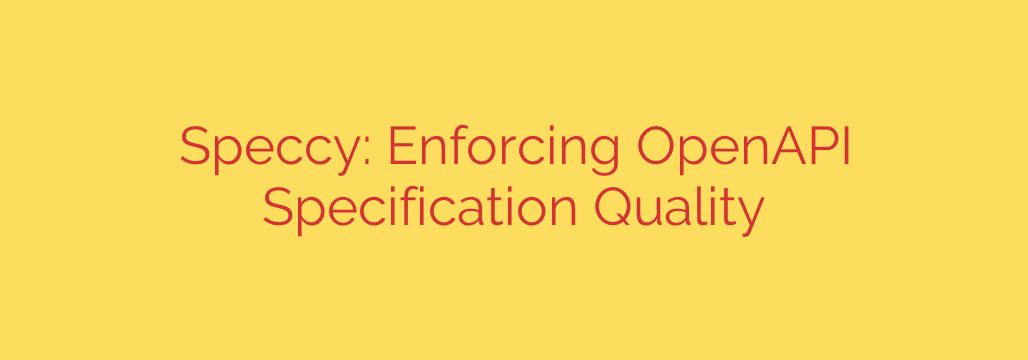
Elevate Your API Quality: A Developer’s Guide to Linting OpenAPI Specs with Speccy
In the world of microservices and interconnected systems, the OpenAPI specification serves as the definitive contract for your API. It’s the blueprint that guides developers, powers documentation generators, and enables automated client/server code creation. But what happens when that blueprint has flaws? The result is often broken tooling, inconsistent endpoints, and a frustrating developer experience.
Maintaining a high-quality, consistent, and error-free OpenAPI specification is not just a best practice; it’s essential for a scalable and reliable API strategy. This is where a dedicated linter and validator becomes an indispensable part of your workflow.
The Problem: Inconsistent and Invalid API Specs
As teams grow and services multiply, it’s easy for API specifications to drift. Different teams might adopt slightly different naming conventions, forget to add descriptions to parameters, or introduce structural errors that aren’t immediately obvious.
These seemingly small issues can cascade into significant problems:
- Failed Code Generation: Tools that generate client SDKs or server stubs will often fail if the spec is invalid.
- Inaccurate Documentation: Auto-generated documentation may render incorrectly or be missing crucial information.
- Integration Headaches: Teams consuming your API will struggle with inconsistencies and unclear contracts.
- Poor API Governance: Without an automated way to enforce rules, your API style guide becomes a suggestion rather than a standard.
To combat this, you need to shift quality control to the left, catching errors early in the development lifecycle, long before they reach production.
Introducing Speccy: Your All-in-One OpenAPI Toolkit
Speccy is a powerful, open-source command-line tool designed specifically to enforce the quality of your OpenAPI (v2/Swagger and v3) specifications. Think of it as ESLint or Prettier, but for your API contracts. It provides a robust suite of features to ensure your specs are not only valid but also adhere to your team’s established best practices.
At its core, Speccy performs three critical functions: validation, linting, and resolving.
1. Flawless Validation
Before anything else, your specification must be syntactically correct. Speccy’s validation engine checks your document against the official OpenAPI Schema, guaranteeing that it is structurally sound. This is the first line of defense against typos and formatting errors that can break the entire ecosystem of tools that rely on your spec.
2. Intelligent Linting for Best Practices
Validation confirms your spec is correct, but linting ensures it is good. This is where Speccy truly shines. It comes with a default ruleset that checks for common best practices and potential pitfalls, such as:
- Ensuring all operations have a
summaryanddescription. - Requiring parameters to include
examplevalues. - Verifying that security definitions are used correctly.
- Enforcing consistent naming conventions (e.g.,
camelCaseorkebab-case).
By linting your specification, you move beyond simple validity to enforce clarity and consistency, which dramatically improves the developer experience for anyone consuming your API.
3. Effortless Dependency Resolving and Bundling
Modern API development often involves splitting a large OpenAPI specification into multiple smaller, manageable files using $ref pointers. While this is great for organization, many tools don’t support these external references.
Speccy solves this with its resolve command. It will recursively follow all local and remote $ref pointers and bundle them into a single, self-contained OpenAPI file. This resolved file is perfectly portable and can be fed directly into any documentation generator, code generator, or API gateway without issue.
Actionable Advice: Integrating Speccy into Your Workflow
The true power of an automated tool is realized when it’s seamlessly integrated into your daily development process. Here’s how you can make Speccy a core part of your CI/CD pipeline.
1. Local Development:
Developers should run Speccy locally before committing any changes to an API specification. A simple command is all it takes:
# Install Speccy via npm
npm install -g speccy
# Lint your specification file
speccy lint ./path/to/api-spec.yaml
This provides immediate feedback, allowing developers to fix issues on the spot.
2. CI/CD Pipeline Integration (e.g., GitHub Actions):
Enforce quality at the source by adding a Speccy check to your CI pipeline. This acts as a quality gate, preventing subpar specifications from ever being merged.
Here is a simple example of a GitHub Actions step:
jobs:
validate-api-spec:
runs-on: ubuntu-latest
steps:
- name: Checkout code
uses: actions/checkout@v3
- name: Set up Node.js
uses: actions/setup-node@v3
with:
node-version: '18'
- name: Install Speccy
run: npm install -g speccy
- name: Lint OpenAPI Specification
run: speccy lint ./docs/openapi.yaml
If the linter finds any errors, the build will fail, forcing the developer to address the problems.
Enforcing Your Own API Style Guide
Speccy is highly configurable. You can create a .speccy.yaml file in your project’s root directory to override the default rules and create a custom API style guide tailored to your organization’s needs.
For example, you can enforce that every single parameter must have a description:
# .speccy.yaml
rules:
# Turn the default 'warn' into a hard 'error'
parameter-description: error
# Require all operationIds to be camelCase
operation-id-case-convention:
- error
- "camelCase"
# Turn off a rule you don't need
no-invalid-media-type-examples: off
This level of customization allows you to automate API governance and ensure that every API produced by your organization has a consistent look and feel.
The Bottom Line: Better Specs, Better APIs
Adopting a tool like Speccy is a strategic move towards building more robust, reliable, and user-friendly APIs. By automating the validation and linting of your OpenAPI specifications, you lay a foundation for:
- Increased Developer Productivity: Fewer errors in the spec mean less time debugging broken tools.
- Enhanced API Consistency: A single source of truth for your API style guide, enforced automatically.
- Faster Onboarding: Clear, well-documented, and predictable APIs are easier for new developers to understand and use.
- Reduced Production Bugs: Catching contract-level issues early prevents them from impacting consumers downstream.
Ultimately, treating your API specification with the same rigor as your application code is the key to success in a distributed, API-first world.
Source: https://www.linuxlinks.com/speccy-enforce-quality-rules-openapi-specifications/








